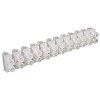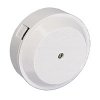Hi to all, this is my first post here so be gentle with me :roll:
I have made a new bathroom door in 5mm aluminium and it slides very easy with ballbearings. Since I am a scifi fan I was thinking of making some sort of automatic open and closing of the door.
Requirements:
- open/close from both inside and outside
- be able to lock it from the inside
- a function that shuts the mechanism off if something/someone is
blocking the door
What I think would be cool:
since the door is aluminium, would it be possible to make the open switch to be the door itself, like those touch switches used in some different lightswitches?
So one little touch to the door and it opens and perhaps have a automatic close function, delay of about 5 sec. and then have a switch inside that turns of the power to the circuit, then the door would be locked.
I will try and attach some picture of the door.
(no comments on the wiring )
)
I have made a new bathroom door in 5mm aluminium and it slides very easy with ballbearings. Since I am a scifi fan I was thinking of making some sort of automatic open and closing of the door.
Requirements:
- open/close from both inside and outside
- be able to lock it from the inside
- a function that shuts the mechanism off if something/someone is
blocking the door
What I think would be cool:
since the door is aluminium, would it be possible to make the open switch to be the door itself, like those touch switches used in some different lightswitches?
So one little touch to the door and it opens and perhaps have a automatic close function, delay of about 5 sec. and then have a switch inside that turns of the power to the circuit, then the door would be locked.
I will try and attach some picture of the door.
(no comments on the wiring



